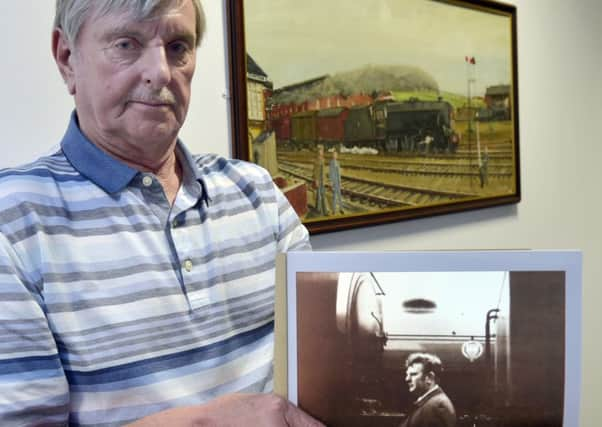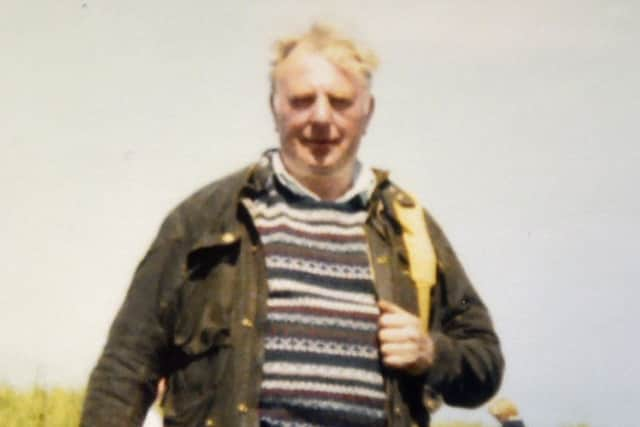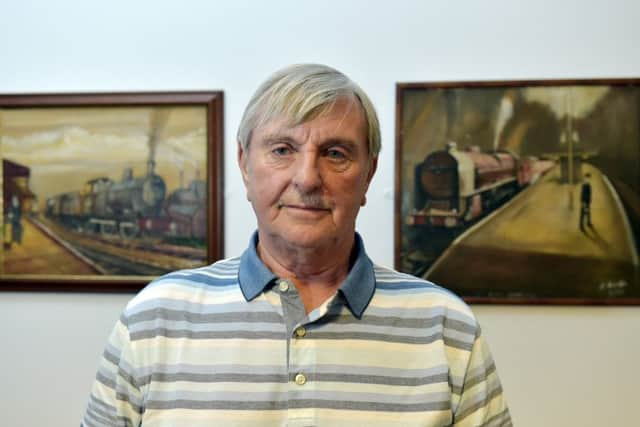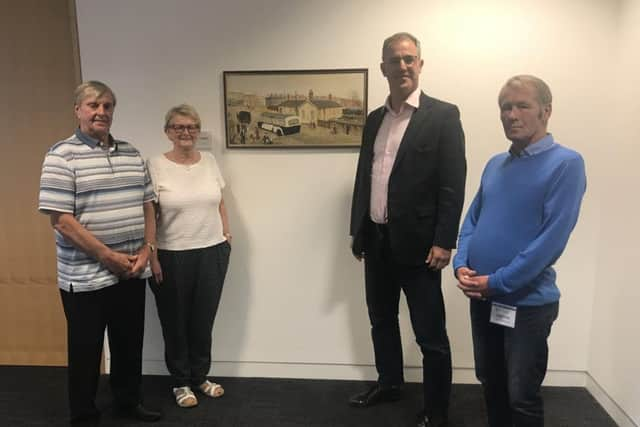Railway signalman's artistic talent kept alive with exhibition 12 years after his death


When Peter Bartle died in 2006, the former railway signalman and lorry driver’s self-taught artistic talent was little known outside his circle of family and friends. But 12 years later, a book of his paintings has been published, some of his artwork has been put on public display and there are plans for a blue plaque to be put up at his former school.
Much of the credit for his work depicting bygone days in his home town of Rotherham and life on Yorkshire’s railways starting to reach a wider audience goes to Peter’s brother and sister-in-law Ralph and Barbara Bartle. After he died at the age of 74, the couple started their own journey of discovery, travelling the country to track down more than 100 paintings he had done.
Advertisement
Hide AdAdvertisement
Hide AdThe paintings discovered by the couple date from the 1980s, a period of time when Peter was living and working on the railways in Filey. His unique methods would see him use the bottoms of old drawers and wardrobes discarded in skips as make-shift canvases and he would do much of his painting while working in the station box at Filey – recreating scenes of Rotherham from 20 to 30 years previously from memory, as well as painting pictures of his beloved trains.


Peter never painted for money but often gave his paintings away as gifts, as well as sometimes exchanging them for board and lodgings; a situation that means Ralph and Barbara believe there is still much of his work they are yet to discover.
A collection of the work Ralph and Barbara have managed to track down has now been published in a book by the Rotherham Civic Society, while it also featured in a major new project about life and culture on British railways that has been organised by researchers at the University of Sheffield and the National Railway Museum.
As part of the initiative, Peter’s work has been put on prominent display at the Sheffield city-centre offices of law firm DLA Piper. Plans are also afoot for the Civic Society to organise the installation of a blue plaque commemorating Peter’s life and work at his old primary school.
Advertisement
Hide AdAdvertisement
Hide AdRalph says his brother’s talent was apparent in their school days, both at his primary Doncaster Road School, which is now East Dene Primary, and then at Spurley Hey Comprehensive School, where teachers encouraged him to consider going to art school. But he chose his other love – the railways – as a career path and left painting behind.


He worked on steam trains but as they were phased out by diesel, he got a job as a lorry driver – part of which involved delivering props to the set of Top of the Pops. But he returned to the railways to work as a signalman, initially around Rotherham before moving to North Yorkshire in the 1970s, where he worked in Scarborough, Malton and Filey – the place where he rediscovered his love of painting.
He began painting scenes from the railways as well as how Rotherham used to look in past decades from memory, with the portraits often including notable local characters from the time such as ‘Vinegar Liz’.
Barbara says: “He did his painting in the signal box at Filey because Filey station only had about half a dozen trains a day passing by.”
Advertisement
Hide AdAdvertisement
Hide AdRalph says the paintings they have found of Peter’s are from a relatively small period of time. “The oldest one we have got is from 1982 and the last one was 1989. He used to throw a lot away.”


Ralph says his self-effacing brother appears to have been discouraged from creating more work after attempting to get his work put on display in Rotherham. “The reason he did actually stop painting was because he approached Rotherham library which had an art gallery and ask them if they had an exhibition he could take part in. They asked if he had a CV and he didn’t even know what one was. After that, it put him off. He gave his paintings away, he didn’t sell them. He would trade them for motorbike parts.”
But he did have some public success with one painting of the Mallard steam train at Scarborough which ended up being displayed in the Mayor of Scarborough’s parlour for several years.
Peter retired in 1997 at the age of 65 and died in 2006 aged 74 – and it was while sorting out his affairs that Ralph and Barbara discovered how much artwork he had created.
Advertisement
Hide AdAdvertisement
Hide AdBarbara says: “He lived by himself and we had to clear his bungalow at Filey. That was when we discovered all those paintings. We thought they were good but maybe because we were family we had always underestimated him a little bit. We also found all these motorbikes in various stages – he had about 13 he was repairing and rebuilding.
“Then other friends of his came forward saying what artwork they had got. Ralph decided we ought to catalogue them and we took pictures of them all. That is how we started off tracking them all down. We ended up travelling to Scarborough and Bridlington and even heard of one in Southampton and they took a picture.
“There are some in America as Pete’s sister lives in America.”
Peter had a lasting influence on his nephew, Ralph and Barbara’s son Richard, who is now himself a professional artist. Richard used to sit in the signal box with Peter while he was doing his paintings. And it was this connection that helped lead to the inclusion of Peter’s work in the Railways Cultures project.
Advertisement
Hide AdAdvertisement
Hide AdRichard got in contact with Dr Amanda Crawley Jackson from the University of Sheffield to tell her about his late uncle’s work when he heard about what the researchers were planning. Dr Jackson, who had walked many of the disused railway lines in South Yorkshire as part of the same project, says it was particularly special for her to see his paintings of those same routes.
“What was amazing was seeing these paintings of what it was like when it was up and running. The National Railway Museum have said it is just a great example of ‘workers’ art’. That is the historical significance.”
Barbara says the opening night exhibition of his work at DLA Piper earlier this year was an emotional experience. “We were very proud when we came that night. I could have cried a lot of the time. I think about what his parents would have thought.”
Running parallel to the university project was the effort by Rotherham Civic Society to publish a book of Peter’s work. Peter Hawkridge, from Rotherham Civic Society, says he had learnt of Peter’s story from someone who had known Mr Bartle in his lorry-driving days. “I hadn’t heard of Pete but when we saw the paintings we realised there was a real talent there and a real individual style he had developed,” he says.
Advertisement
Hide AdAdvertisement
Hide AdWith the blue plaque due to go up at Peter’s old school in October, more than a decade after his death, it is full steam ahead for ensuring Peter’s artistic contribution is kept alive.
Railway project has led to new book
Peter Bartle’s work is a major part of the Railway Cultures project which has taken an in-depth look at different facets of the life and culture of Yorkshire’s railways.
The initiative, involving the University of Sheffield and the National Railway Museum in York, also involves specially commissioned photographs of the abandoned colliery lines of Yorkshire and snapshots of contemporary regional rail passengers.
Results from the collaboration also include a book, which features artworks and short essays about the collections held in the National Railway Museum’s archives.
University students and staff have also been commissioned to write short stories and poems for a creative writing journal.